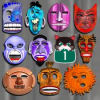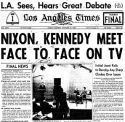 A few days ago, I wrote a post titled “Navigating the Minefield” where I discussed three interesting societal divides: (1) how do we deal with old, potentially problematic, music; (2) the divide about coats on the UW Madison campus; and (3) how autonomous automobiles may have a significant impact on privacy. WIth respect to the following news chum items, item (1) is particularly applicable. Titled “The Music I Love Is a Racial Minefield“, it explored the problem of music, and playing songs that had problematic history, origins, or words — such as the Star Spangled Banner, where the full version as written includes a verse in which slave owner Francis Scott Key, an outspoken white supremacist, rails against “the hireling and the slave.” I recommend everyone read that piece, which includes the following paragraph by an artist I enjoy, Dom Flemons (the American Songster):
A few days ago, I wrote a post titled “Navigating the Minefield” where I discussed three interesting societal divides: (1) how do we deal with old, potentially problematic, music; (2) the divide about coats on the UW Madison campus; and (3) how autonomous automobiles may have a significant impact on privacy. WIth respect to the following news chum items, item (1) is particularly applicable. Titled “The Music I Love Is a Racial Minefield“, it explored the problem of music, and playing songs that had problematic history, origins, or words — such as the Star Spangled Banner, where the full version as written includes a verse in which slave owner Francis Scott Key, an outspoken white supremacist, rails against “the hireling and the slave.” I recommend everyone read that piece, which includes the following paragraph by an artist I enjoy, Dom Flemons (the American Songster):
“People are trying to find modern sensibilities in stuff that was not built on modern sensibilities,” Flemons told me. In 2015, he performed an instrumental version of Stephen Foster’s “Ring, Ring de Banjo” at a Foster-themed event with the Cincinnati orchestra. Foster’s racist lyrics are “absolutely unacceptable” nowadays, and “I would never think to perform that song outside the context of that specific show,” Flemons says. But these once-popular songs “are a document of what happened,” and failing to acknowledge that history would “completely devalue the strength of how far we’ve come.”
The following three news chum pieces evoked in me similar feelings to the “Racial Minefield” article, and are worthy of your consideration:
- Sexual Predators. How do we separate the art from the artist? That’s a big question in these days of #MeToo and TimesUpNow. In particular, how do we treat the art created by these individuals we now know were predators and harassers? Can I still enjoy Fat Albert and Bill Cosby’s routines, knowing his history? What about watching “Annie Hall”? Vox has a great opinion piece on the subject titled “How to think about consuming art made by sexual predators“. It’s conclusion is that the answer is not easy. The basic conclusion, according to a historian consulted in the article, is to put everything in context: “As a historian, I strongly believe that it’s important that we keep these men’s work accessible. Woody Allen films are a genuinely important part of American film history. The Cosby Show is key to understanding representation in media and tangled issues of race, class, and acceptance. But I also can’t imagine watching old episodes simply for entertainment.” But where do you fall on the subject? Can you listen to Bill Cosby, or watch the artwork of Gaugain, the same anymore?
- Smoking. In a somewhat similar vein is an article by Peter Filchia in Masterworks Broadway about the context of musical plots or dialogue that centers on smoking. Many shows were written at the time that smoking was ingrained in American society. Certainly the classic musicals of the 1950s make jokes about smoking. Look at the lines in musicals that refer to smoking, and look at the musical writers that also penned cigarette jingles. Filchia doesn’t draw a particular conclusion, but does really demonstrate how musicals are a product of their times. (Which, I’ll note, is why shows like Showboat remain problematic, as does the behavior of Rosemary in How to Succeed — how would we view today a woman that predatory towards her male boss?)
- Confederate Iconography. The last article of interest is from Religion News, and has to do with changing names of things named after Confederate Icons. It is one thing to take down a stature, or to rename an elementary school that has no connection to the person. What do you do if you need to rename a church where he actually worshipped or was memorialized? This article, titled “Our church was named for Robert E. Lee — here is how we changed it” explores just that issue. It talks about three churches : (1) St. Paul’s Episcopal Church in downtown Richmond, which is the church Robert E. Lee and Confederate President Jefferson Davis attended during the Civil War; (2) Christ Church, in Alexandria, a 1773 Episcopal parish that claims George Washington and the Lee family as former worshippers; and (3) R.E. Lee Memorial Episcopal Church in Lexington VA, where Robert E. Lee was senior warden after he joined the church in 1865.
All four of these articles, which are fascinating reads, demonstrate why reconciling the facts of history with the emotion of people and with common sensibilities is never easy.
 Yesterday was a museum day for us in Klamath Falls, as we visited the Favell Museum of Native American Artifacts and Contemporary Western Art. Although the artwork itself was beautiful (especially the miniatures collection), I found myself conflicted in a number of different ways.
Yesterday was a museum day for us in Klamath Falls, as we visited the Favell Museum of Native American Artifacts and Contemporary Western Art. Although the artwork itself was beautiful (especially the miniatures collection), I found myself conflicted in a number of different ways.

 Over lunch, I was reviewing my accumulated potential news chum links. There had been some interesting articles over the last few days that had piqued my interest (got it right this time), but what would theme? Then it hit me — a connection between articles. All of these have to do with factors that shape our perception and our history, especially in California and Los Angeles in particular.
Over lunch, I was reviewing my accumulated potential news chum links. There had been some interesting articles over the last few days that had piqued my interest (got it right this time), but what would theme? Then it hit me — a connection between articles. All of these have to do with factors that shape our perception and our history, especially in California and Los Angeles in particular. It’s been an interesting week. Although I was collecting a bunch of news chum, they never coalesced in my head into a coherent post. Now it’s the weekend, so let’s start clearing them off. This first collection provides a bunch of histories that I found of interest:
It’s been an interesting week. Although I was collecting a bunch of news chum, they never coalesced in my head into a coherent post. Now it’s the weekend, so let’s start clearing them off. This first collection provides a bunch of histories that I found of interest: Clearing out some more news chum — this time with something you can really chew on:
Clearing out some more news chum — this time with something you can really chew on: A few days ago, I wrote a post titled “
A few days ago, I wrote a post titled “ Two days after Thanksgiving. You’ve made your stock from the turkey carcass, and have just about finished the meat in the frig, but you’re still working on all the sides that were leftover. All. The. Sides. So many sides. Here on this blog, we face a similar problem: What to do with all the links accumulated that just stubbornly refuse to theme? The answer, of course, is to make stew:
Two days after Thanksgiving. You’ve made your stock from the turkey carcass, and have just about finished the meat in the frig, but you’re still working on all the sides that were leftover. All. The. Sides. So many sides. Here on this blog, we face a similar problem: What to do with all the links accumulated that just stubbornly refuse to theme? The answer, of course, is to make stew: Today’s collection of news chum addresses two areas of interest to me: origin stories, and reports of things disappearing. Origin stories are interesting because we don’t often know where some popular things come from; many come from new or emerging trends. Disappearance stories, on the other hand, are often reflective or indicative — again — of trends in society.
Today’s collection of news chum addresses two areas of interest to me: origin stories, and reports of things disappearing. Origin stories are interesting because we don’t often know where some popular things come from; many come from new or emerging trends. Disappearance stories, on the other hand, are often reflective or indicative — again — of trends in society. As Jack Webb almost once said (
As Jack Webb almost once said (